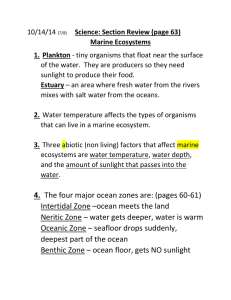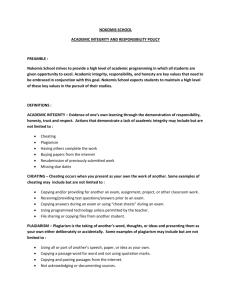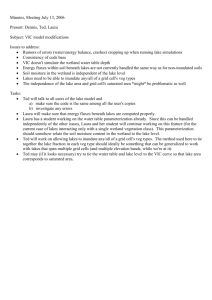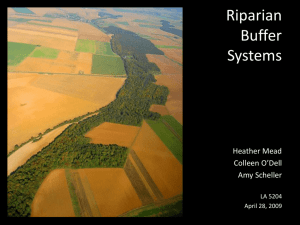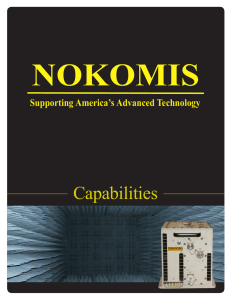Examples of Riparian Buffers
advertisement
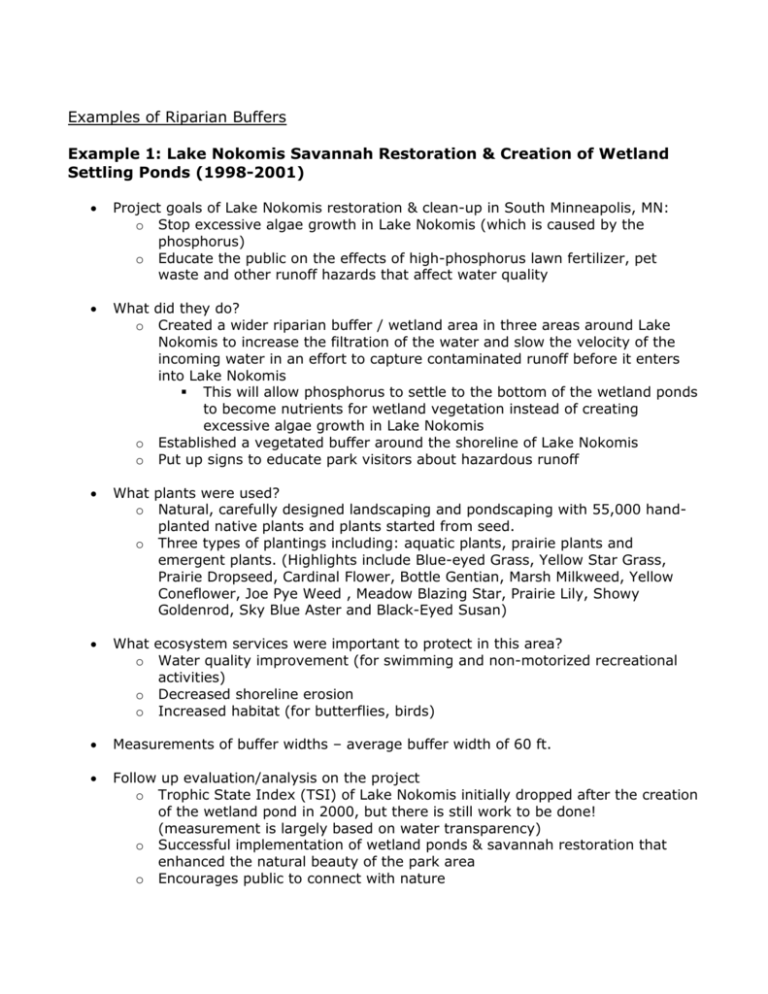
Examples of Riparian Buffers Example 1: Lake Nokomis Savannah Restoration & Creation of Wetland Settling Ponds (1998-2001) Project goals of Lake Nokomis restoration & clean-up in South Minneapolis, MN: o Stop excessive algae growth in Lake Nokomis (which is caused by the phosphorus) o Educate the public on the effects of high-phosphorus lawn fertilizer, pet waste and other runoff hazards that affect water quality What did they do? o Created a wider riparian buffer / wetland area in three areas around Lake Nokomis to increase the filtration of the water and slow the velocity of the incoming water in an effort to capture contaminated runoff before it enters into Lake Nokomis This will allow phosphorus to settle to the bottom of the wetland ponds to become nutrients for wetland vegetation instead of creating excessive algae growth in Lake Nokomis o Established a vegetated buffer around the shoreline of Lake Nokomis o Put up signs to educate park visitors about hazardous runoff What plants were used? o Natural, carefully designed landscaping and pondscaping with 55,000 handplanted native plants and plants started from seed. o Three types of plantings including: aquatic plants, prairie plants and emergent plants. (Highlights include Blue-eyed Grass, Yellow Star Grass, Prairie Dropseed, Cardinal Flower, Bottle Gentian, Marsh Milkweed, Yellow Coneflower, Joe Pye Weed , Meadow Blazing Star, Prairie Lily, Showy Goldenrod, Sky Blue Aster and Black-Eyed Susan) What ecosystem services were important to protect in this area? o Water quality improvement (for swimming and non-motorized recreational activities) o Decreased shoreline erosion o Increased habitat (for butterflies, birds) Measurements of buffer widths – average buffer width of 60 ft. Follow up evaluation/analysis on the project o Trophic State Index (TSI) of Lake Nokomis initially dropped after the creation of the wetland pond in 2000, but there is still work to be done! (measurement is largely based on water transparency) o Successful implementation of wetland ponds & savannah restoration that enhanced the natural beauty of the park area o Encourages public to connect with nature Example 2: Sugar River Crossing Conservation Development Project goals of Sugar River Crossing Conservation Development in Albany, WI: o Preserve natural resources while permitting the need for development o Recreate habitat (within prairie, woodland and wetland areas) o Encourage lot-owners to use native landscaping and environmentally friendly practices o Provide recreational opportunities for lot-owners What did they do? o Created two common conservancy areas that all of the private lot-owners share (there are 41 lots within the development) o Created five wildlife water scrapes (shallow ponds) to re-establish the natural habitat for wildlife in the former cornfields o Put in canoe slips so that lot-owners have an access points to put canoes in the river o Established unobtrusive picnic areas and nature trails o Replanted natural vegetation near the river and around the development What plants were used? o Upland prairie seed mixes What ecosystem services were important to protect in this area? o Wildlife habitat + connectivity Measurements of buffer widths – N/A Follow up evaluation/analysis on the project o Maintained more than 50% green space within the 165 acre development o Maintained a wide riparian buffer with extremely diverse habitat areas between the Sugar River and the residential lots Other points: Riparian buffers come in many forms and these examples demonstrate two alternative landscape possibilities. o The first example (Lake Nokomis) is considered an alternative landscape because they incorporated native vegetation as well as wetland ponds in an urban park setting. This necessitated educational signs for the public so that they could understand and see the benefits of this new landscape. It also incorporated this new version of aesthetic beauty while also providing ecological services in terms of addressing water quality concerns. o The second example (Sugar River Crossing) is considered an alternative landscape because it is based on a new development model that emphasizes sustainability and conservation in a residential area. The riparian buffer has been deemed ecologically significant to the people who live in the nearby lots and they have chosen to preserve the natural habitats that exist there while also retaining the sense of place that this landscape exhibits. Other examples of alternative landscapes that may include riparian buffer areas are greenways, conservation reserve and wetland reserve plantings, wetland restorations, wildlife corridors and constructed wetlands. References: http://www.minnehahacreek.org/lake_nokomis_ponds.php http://www.minnehahacreek.org/lake_nokomis_faq.php http://www.nokomiseast.org/association/BWA/bwa-report-2002.html http://minneapolisparks.org/documents/design/LakeNokomisLandscape.pdf http://www.appliedeco.com/Projects/sugarxing.pdf http://www.sugarrivercrossing.com/CONSERVANCY%20SRC.html http://www.sugarrivercrossing.com/Text/SRC%20WSJ%20Article.pdf


